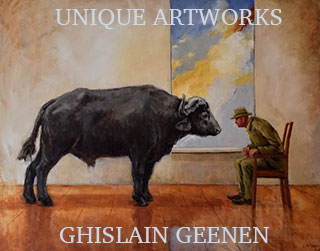The painting is by JOHN SEEREY- LESTER ( 1945 -) in acrylics and ia titled “ Misguided”. It shows a hunter and his guide with a large tiger sitting on rocks above them. There is a true story behind this painting. It is inspired by Jim Corbett's hunt for the Maneater of Chowgarth, in 1929. Corbett spent a year tracking the “man-eater of Chowgarh”, a tiger which had conducted a reign of terror by killing 64 people in 4 years. His remarkable quest is recounted here in words and paint by artist John Seerey-Lester, whose website explains the story. The original source is Corbett's own book 'Maneaters of Kumaon'.
Jim Corbett arrived in the Kala Agar Forest in Eastern Kumaon, India, on an April evening in 1929. At that time the tiger known as the “man-eater of Chowgarh” had conducted a reign of terror for some four years and had killed 64 people. Corbett had already dispatched the famous “Champawat man-eater”, responsible for an incredible 436 deaths, and had now become the man to ask if you wanted to get rid of a man-eater. The District Conference recruited him again.
Corbett knew that finding this tiger would be very difficult; the kills accredited to this tiger had taken place over some 1500 square miles. Some attacks were as distant as 50 miles apart and, in this terrain, that is a lot to cover for one man. Corbett preferred to hunt alone, and on foot, and his search area was a maize of small villages interconnected by well-worn tracks, some going through dense jungle. His base camp was a small bungalow in the kala Agar forest provided by the Government. From here he would try and visit as many of the kill sites as possible, talk to the relatives of the victims and those who had witnessed the attacks. If possible, he would return to the bungalow as often as he could.
During his year-long quest he had been misguided and misinformed several times which had led him to incorrectly identify two tigers, which he had shot by mistake. Frustrated, but not beaten, he returned home for the rains and came back to the area at the end of the March 1930. By this time some 26 more people had been killed. He spent another 19 days trekking the forest on foot without success. Oh yes, he had seen the pugmarks of the tigress many times; he knew their characteristics off by heart, but he had not encountered the tigress. On April 10th, this all changed.

He had been watching a kakar (barking deer) grazing on a hill, and experienced an inexplicable uneasiness as he approached some rocks ahead of him on the narrow track. As he cautiously walked towards the outcrop he was remembering that tigers are unaware that humans don’t have a good sense of smell, so a man-eater will treat human prey in the same way it would treat a wild animal. It will approach its victim up wind or lie in wait, down wind. He realizes the rocks ahead are down wind, a perfect place for the tigress to lie in wait, he muses. Just then the kakar let out an alarm call and was now running up the hill to his right and barking hysterically.
Trying to keep down wind, he walked warily 'round the large outcropping. Keeping his distance to avoid an ambush, he reached where the kakar had first made its alarm call, but could see nothing. Cautiously he backtracked 'round the rocks, and there in the damp clay he saw the all too familiar splayed and scarred pugmarks of the man-eater. But to his dismay, he noticed that these tracks were over his own footprints, made earlier. The tigress had, indeed, been waiting for him in the rocks and had jumped down to follow him. The alarmed kakar had probably saved his life. The tigress had presumably gone into the deep undergrowth or was waiting for him 'round the next bend. As the light was fading fast giving the tigress a definite advantage, he decided to call it a day and resume the hunt in the morning.
By early afternoon, the next day, he had hiked along a track to where a young boy had been killed a month earlier. He met the father of the boy and some other villagers who showed him where the incident had taken place. He followed them to the site; on the way Corbett, an avid collector of bird’s eggs, was distracted by an unusual clutch of nightjar eggs, which he decided were a must for his collection. Holding the eggs in the palm of his hand, he surrounded them with some moss for protection, and then traversed the steep and rocky ravine; his guides were now his followers and were staying close behind. At one point Corbett sat on top of a large round rock, handed his rifle to one of the men and then, after a few moments looking around, slid down the smooth rock, leaping the last few feet, still holding the eggs. The men followed in similar fashion. One of them said they had heard a low growl, just as Corbett had moved from the top of the rock. Corbett assumed he had been selected by the tigress, and the low growl was a show of disappointment, as he had slipped from her striking range. The three men, the father closer to Corbett than the others, walked in single file 'round the face of the large rock, which leaned over a ravine. There was a tangle of bushes on top of the outcrop and soft sand beneath.
As Corbett rounded the main rock, he entered a flat sandy area enclosed on three sides by steep rocks. There lying only eight feet away and facing him with her hind legs tucked under her, ready to pounce, was the illusive, “man-eater of Chowgarh”. Still holding the eggs in his left hand, his heart pounding fast, the rifle in his right hand, pressed diagonally against his chest with the safety off, he very slowly swung the rifle with one hand and began to make a quarter circle. With the stock in contact with his right side, he extended his arm and continued to swing until it was fully extended baring the full weight of the gun. All the time, the almost smiling tigress, stared at Corbett and he returned her gaze. The gun having completed its seemingly endless three quarter turn, was now lined up with her body; he pulled the trigger. The report was deafening in the confined space of the rocks. The tigress died without moving, lowering her head on to her front paws. Shot clean through her heart.
Corbett knew, even before looking at her pads, that it was the tigress he sought, and he had finally ridded the Kala Agar Forest of its terror.
Like all man-eaters, three was a reason for its change in diet. On close inspection it was found that her claws were broken, and bushed out. One of her canines was broken and her front teeth were worn down to the bone.
Published by Vintage Guns Ltd on



